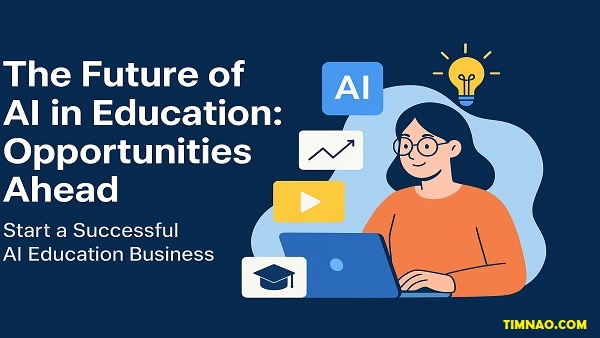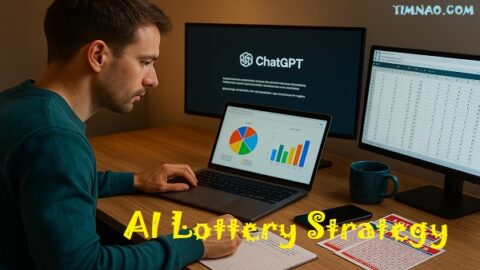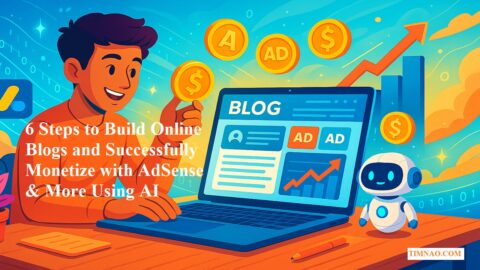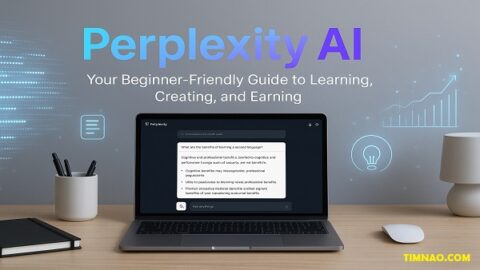Unlock Passive Income with AI Study Guides 🚀: A Beginner’s Blueprint to Profit in EdTech
AI education business is no longer just for big companies or tech experts—it’s now an opportunity anyone can tap into. With the rise of powerful yet affordable tools like ChatGPT, Canva, and QuizGecko, creating personalized study guides, flashcards, and quizzes has never been easier. What was once expensive and complex can now be built on a shoestring budget and turned into a steady source of passive income.
Imagine turning your teaching notes, study tips, or subject expertise into interactive digital products that students actually enjoy using. Whether it’s flashcards that adapt to a learner’s strengths, gamified quizzes that make revision fun, or AI-driven study guides that feel tailor-made, the possibilities are endless. The best part? You don’t need to be a coder or an edtech professional to get started.
In this guide, you’ll discover how beginners can build and grow an AI-powered education venture with minimal upfront investment. We’ll cover affordable tools, practical design strategies, proven monetization models, and real-world success stories that show what’s possible. If you’ve ever wanted to combine your knowledge with technology to create something impactful—and profitable—this is your roadmap.
📑 Table of Contents
- 📚 Why AI Study Tools Are Booming
- 🤖 How AI Makes Education Entrepreneurship Easy
- 💡 Affordable Tools to Kickstart Your AI Education Business
- 🎨 Designing Study Guides That Actually Work
- 🃏 Quizzes, Flashcards & Gamification: Keeping Learners Engaged
- 💸 Smart Monetization Models for Beginners
- 📈 Marketing Your AI Study Tools Without Breaking the Bank
- 🌍 Scaling Beyond Borders: Turning Side Hustle Into Business
- ⚖️ Legal & Ethical Essentials for AI Education Startups
- 🚀 Real Case Studies: Successes and Failures to Learn From
- 🔮 The Future of AI in Education: Opportunities Ahead
- 🙋 FAQs: Beginner Questions About AI Education Business Answered
📚 Why AI Study Tools Are Booming
Students today no longer settle for bulky textbooks or one-size-fits-all revision guides. Just like Netflix recommends the next movie or Spotify builds personalized playlists, learners now expect their study tools to be personalized, adaptive, and interactive. That’s exactly why AI study guides, quizzes, and flashcards are growing at record speed.
Instead of passively reading 40 pages of biology, a student can open an AI-powered flashcard app that highlights their weaknesses and skips what they already know. The learning experience becomes faster, more engaging, and less stressful. This adaptive learning approach is what sets AI tools apart—and students love it.
The numbers speak for themselves. The global e-learning industry is expected to surpass $500 billion by 2030, with AI-powered personalization as one of the fastest-growing categories. What this means for beginners is simple: there has never been a better time to launch an AI education business. The demand is exploding, and the entry barriers have never been lower.
💡 Real-World Example
A language learner in Spain struggled with grammar rules, so she used ChatGPT to create personalized exercises for herself. When she realized others faced the same challenge, she packaged the content into an online subscription product. Within six months, she grew to over 300 paying subscribers, earning a few hundred euros per month—all from a tool she originally built for personal use.
This story shows that you don’t need to be a teacher, a tech professional, or a large company to join the boom. All you need is an idea, a basic understanding of AI tools, and the willingness to test your product in the market.
👉 Beginner takeaway: The AI study tool market is booming because students want faster, smarter, and cheaper ways to learn. If you can solve a real learning problem—even in a small niche—you can turn it into an income stream.
🤖 How AI Makes Education Entrepreneurship Easy
Not long ago, creating an education platform required months of coding and thousands of dollars in investment. That barrier has disappeared. Today, with AI and no-code platforms, anyone can create professional-looking study resources—even with zero technical skills.
Imagine this:
- You use ChatGPT to generate practice questions for high school math.
- You design polished flashcards in Canva using drag-and-drop templates.
- You import the questions into QuizGecko to make an interactive quiz that adapts to student performance.
In just a few hours, you’ve created a mini learning product that looks like it was built by a professional team. That’s the power of AI for education entrepreneurship.
🚀 Why It’s So Accessible
- Low cost: Many AI tools have free plans, and premium versions start as low as $10–20/month. You can launch your first product for under $500 total investment.
- No coding needed: Platforms are built for non-technical users, with drag-and-drop features and ready-made templates.
- Speed: Instead of months of development, you can create a testable product in days—or even hours.
💡 Real-World Examples
- A retired math teacher in the UK used AI to create colorful flashcards for calculus and sold them on Teachers Pay Teachers. Within weeks, she made $2,000 in sales.
- A university student created a grammar-fixing chatbot powered by ChatGPT and listed it on Gumroad. It grew into a $2,000/month side hustle.
Both examples started with simple ideas and low upfront costs. They didn’t build huge apps or hire teams. They simply used AI to create solutions that solved real learning problems.
✅ Quick-Start Checklist (Try This in 24 Hours)
- Pick a subject you know (math, history, coding basics, or even hobbies like music theory).
- Ask ChatGPT to generate 20 practice questions or a summary guide.
- Design flashcards or a PDF study guide using Canva.
- Upload it to a platform like Ko-fi or Etsy and set a price.
That’s it—you now have your first AI-powered digital product online. Even if it makes just $10 at first, you’ve proven the concept and can scale from there.
💵 How This Translates Into Income
The best part is that these tools aren’t just useful—they’re profitable. You can monetize them in several beginner-friendly ways:
- Subscriptions: Charge $5/month for unlimited flashcard or quiz access.
- One-time sales: Sell a study guide or quiz pack for $9.99 on Etsy or Gumroad.
- Licensing: Offer your product to schools or tutoring centers for a yearly fee.
👉 Example: A biology tutor combined her printed anatomy posters with QR codes that linked to AI-powered quizzes. Students loved the interactive add-on, and her sales doubled in just two months.
🎯 Key Takeaway
AI has made education entrepreneurship easier, faster, and cheaper than ever. You don’t need coding skills, a large budget, or a full-time team. You only need to:
- Pick a subject or problem,
- Use AI to build a solution,
- Test it with real learners.
For beginners, this is one of the most accessible ways to start an online business in 2025. The AI education business isn’t just a trend—it’s an open door for anyone willing to take the first step.
💡 Affordable Tools to Kickstart Your AI Education Business
Starting an AI education business doesn’t require a massive budget. In fact, many successful entrepreneurs launch with less than $500 in total costs. The key is choosing the right mix of affordable (and often free) tools that help you build, design, and sell your products without technical headaches.
🚀 The Core Starter Toolkit for Beginners
Here’s a simple, cost-effective toolkit to get you off the ground:
- Content Creation – ChatGPT
- Generate study guides, quizzes, summaries, and flashcards.
- Cost: Free plan available; $20/month for ChatGPT Plus (recommended for faster, higher-quality responses).
- Design – Canva
- Create professional flashcards, infographics, and PDFs.
- Cost: Free plan available; Pro version $12.99/month.
- Interactive Quizzes – QuizGecko
- Automatically turns your notes or documents into quizzes.
- Cost: $12/month starter plan.
- Workflow Automation – Zapier
- Connects your tools (e.g., auto-send quizzes after someone purchases your guide).
- Cost: Free for basic automations; starter plan $20/month.
- Selling Platform – Gumroad or Ko-fi
- Instantly sell PDFs, flashcards, or subscriptions with no coding.
- Cost: Free to start (platform takes a small % of sales).
👉 With just these tools, you can design, package, and sell a learning product in less than a week.
💡 Real-World Example
- A high school teacher in Canada used ChatGPT to create a set of chemistry flashcards, polished them in Canva, and uploaded them to Teachers Pay Teachers. The startup cost? $33 total (just a Canva Pro subscription). Within 60 days, she made over $800 in sales.
✅ Quick-Start Checklist: Budgeting Your First $100
If you’re unsure where to start, here’s how you could allocate your first $100:
- ChatGPT Plus – $20
- Canva Pro – $13
- QuizGecko – $12
- Gumroad fees – Free to start
- Test ads (Facebook/Instagram) – $50
That’s it—you’re in business.
🏆 Pro Tips for Saving Money
- Use free trials: Most tools give you 7–30 days free.
- Start with free tiers: Canva, Zapier, and Ko-fi have robust free versions.
- Reinvest profits: Upgrade only when your product starts generating income.
👉 Beginner takeaway: Don’t overthink tools. Pick a few, start small, and focus on launching your first product instead of chasing “perfect” setups.
🎨 Designing Study Guides That Actually Work
Having the right tools is just step one. The real test of your AI education business is whether your study guides actually help people learn. If your product feels confusing, overwhelming, or generic, students won’t buy it—or worse, they’ll ask for refunds.
Here’s how to design study guides that deliver value, build trust, and keep learners coming back.
📏 Keep It Modular and Digestible
Students are busy. They don’t want to wade through 30-page PDFs. Instead, break content into bite-sized sections they can complete in 5–10 minutes.
- Example: Instead of a long “World War II” guide, split it into smaller topics: Causes, Major Battles, Aftermath, Key Leaders.
- Action tip: Each section should answer one key question or solve one learning problem.
🎨 Make It Visual
Visuals improve retention and make your guides more engaging. Use infographics, diagrams, and icons to simplify complex concepts.
- Tool tip: Canva offers thousands of education templates you can customize in minutes.
- Example: A biology tutor designed a cell structure infographic in Canva, included it in her study guide, and shared a printable version as a bonus. Her students loved it—and she sold over 500 copies on Etsy.
🤖 Personalize with AI
Generic study guides are everywhere. What makes AI unique is its ability to adapt to learners’ needs.
- Use ChatGPT to create “choose your difficulty” study notes (beginner, intermediate, advanced).
- Add interactive quizzes that adjust difficulty based on answers.
- Example: A Spanish language creator offered three versions of her guide (Beginner Phrases, Intermediate Grammar, Advanced Idioms) and bundled them as one product. She doubled her sales by appealing to multiple learner levels.
🎮 Add Gamification
Students are more likely to stay motivated when learning feels like a game. Add elements such as:
- Badges for progress (e.g., “Completed 5 quizzes in a row”).
- Streak tracking (like Duolingo).
- Unlockable bonuses (extra tips, cheat sheets).
- Example: A law student turned exam prep into a “courtroom challenge” game with objection-based flashcards. Engagement skyrocketed, and she sold subscriptions to classmates who previously hated studying.
✅ Quick-Start Checklist: Building Your First Guide
- Choose your subject (e.g., Algebra basics, English grammar, Music theory).
- Use ChatGPT to generate a 10-question quiz + summary notes.
- Design a clean PDF or flashcard set in Canva.
- Add at least 1 visual per page (diagram, chart, or icon).
- Export as a PDF and upload to Gumroad, Ko-fi, or Etsy.
In just a weekend, you can launch your first AI-powered study guide.
💡 Money-Making Application
Don’t stop at one guide. Once you validate demand, expand into:
- Bundles: Combine multiple guides into one premium package.
- Subscriptions: Offer new flashcards or quizzes every month.
- Licensing: Sell bulk access to schools or tutoring centers.
👉 Example: A history graduate started with a single PDF on “Cold War Essentials.” After getting traction, she expanded into a monthly “History Pack” subscription for $5/month. Today, she earns over $1,500/month from repeat customers.
🎯 Key Takeaway
Affordable tools give you the power to build AI education products with almost no technical barriers. But tools alone don’t make your business succeed—effective design does. Focus on modular, visual, and personalized study guides that keep learners engaged. Pair that with simple monetization models, and you’ll have the foundation for a profitable AI education business that students actually value.
🃏 Quizzes, Flashcards & Gamification: Keeping Learners Engaged
The biggest challenge in education isn’t just delivering information—it’s keeping learners engaged long enough to remember it. Traditional study methods like highlighting textbooks or rereading notes often feel boring, and students quickly lose focus. That’s where quizzes, flashcards, and gamification come in. These tools transform passive studying into an active, rewarding experience.
🎯 Why Quizzes Work So Well
Quizzes are powerful because they trigger something called active recall—the process of pulling information from memory rather than just reviewing it. Active recall has been proven to dramatically improve retention compared to passive learning.
- Example: Instead of rereading 20 pages of history notes, a student who takes a 10-question quiz will retain more key facts.
- Tool tip: Use QuizGecko or Typeform to instantly turn notes into interactive quizzes.
👉 Beginner takeaway: Even a simple 5-question quiz at the end of a study guide makes your product 10x more valuable to learners.
🃏 Flashcards: Bite-Sized Learning That Sticks
Flashcards are one of the oldest learning tools, but AI makes them smarter than ever. Instead of generic decks, AI-generated flashcards can adapt to a learner’s progress.
- Example: A student struggling with algebra can be shown the same problem in multiple variations until they master it.
- Tool tip: Anki and Quizlet allow AI-powered spaced repetition—showing cards at intervals that maximize memory.
For entrepreneurs, flashcards are easy to create and package into digital products. You can sell them as:
- Printable PDFs (on Etsy or Gumroad).
- Digital decks for apps like Anki.
- Bundles with quizzes and study guides.
👉 Beginner takeaway: Flashcards are quick to produce, easy to sell, and highly effective for learners.
🎮 Gamification: Making Learning Fun
Gamification takes engagement to another level by making learning feel like a game. Students stay motivated when progress is tracked, rewards are given, and learning feels interactive.
Popular gamification features include:
- Points & Badges: Reward learners for completing modules or quizzes.
- Streaks: Encourage consistency, like Duolingo’s daily streaks.
- Challenges: Let learners “unlock” harder quizzes or bonus content.
💡 Real Example: A college student created a quiz app that mimicked a “boss battle.” Each quiz represented a challenge, and passing it unlocked the next level. The playful design boosted daily engagement by 70% compared to traditional quizzes.
👉 Beginner takeaway: Adding simple gamification elements makes learners return again and again, increasing your product’s long-term value.
✅ Quick-Start Checklist: Engagement Toolkit
- Add at least 1 quiz to your study guide.
- Create a flashcard deck (20–30 cards) on a specific topic.
- Add progress tracking (e.g., a checklist or streak counter).
- Offer a bonus reward (like a cheat sheet) for learners who finish a module.
In less than a weekend, you can make your study product more engaging than most traditional resources.
💸 Smart Monetization Models for Beginners
Building an engaging product is only half the journey—the other half is turning it into income. The good news? Education products are highly flexible to monetize, even for beginners. Let’s explore some beginner-friendly models.
1. 🎟️ One-Time Product Sales
The simplest model: sell a study guide, flashcard deck, or quiz pack for a fixed price.
- Example: A nursing student created a “Pharmacology Flashcard PDF” and sold it on Etsy. She priced it at $7.99 and made over $500 in the first month.
- Best for: Beginners testing their first product.
2. 🔄 Subscription Model
Instead of one-time sales, offer ongoing access to new study materials. This creates recurring income, which is more sustainable.
- Example: A language tutor offered a $5/month subscription for “Weekly Spanish Flashcards.” Within 6 months, she had 400+ subscribers, generating over $2,000/month.
- Tools: Ko-fi, Patreon, or Gumroad memberships.
3. 🎓 Course Bundles
Combine multiple study guides, quizzes, and flashcards into a mini-course. Learners love bundles because they feel like a complete solution.
- Example: A history graduate created a bundle called “Crash Course: Cold War,” which included 3 PDFs, 2 quizzes, and a flashcard deck. She sold it for $29 and quickly outsold her individual products.
4. 🏫 B2B Licensing
Don’t forget schools, tutoring centers, and training programs. They often need ready-made learning materials and are willing to pay bulk prices.
- Example: A biology tutor packaged her flashcards and quizzes into a “School Edition.” She sold licenses to three high schools for $300/year each.
5. 📈 Freemium Model
Offer a free version to attract users, then charge for premium features.
- Free: Basic flashcards or a sample quiz.
- Paid: Full deck, advanced quizzes, or bonus materials.
This strategy builds trust before asking learners to pay.
✅ Quick-Start Checklist: Monetization for Beginners
- Start with 1 simple paid product ($5–10).
- Offer a free sample to build trust.
- Collect feedback from first buyers and improve.
- Test a subscription option once you have repeat customers.
💡 Pro Tips for Beginners
- Niche down: Don’t try to cover everything. Focus on one subject or exam.
- Price low to start: $5–10 products convert better for new sellers.
- Upsell later: Once you have buyers, offer bundles or subscriptions.
👉 Example: A coding bootcamp graduate started selling “JavaScript Quiz Packs” for $7 each. After 200 sales, he launched a $15/month subscription that included new quizzes every week. Within a year, he was making over $3,000/month.
🎯 Key Takeaway
Engagement comes first—quizzes, flashcards, and gamification keep learners motivated. But monetization is what turns your effort into profit. Start simple with one-time sales, then expand into subscriptions, bundles, or licensing as your audience grows. With AI and affordable tools, even beginners can create engaging study products and turn them into reliable income streams.
📈 Marketing Your AI Study Tools Without Breaking the Bank
You might have the most engaging study guide or quiz pack in the world, but if nobody knows it exists, it won’t sell. The good news is that you don’t need a massive advertising budget to market your AI education business. With a few smart strategies, you can get your products in front of the right audience—without spending hundreds on ads.
🎯 Start With Free Platforms
Your first goal is visibility. Luckily, there are several free platforms where students are already searching for resources:
- Etsy: Perfect for selling printable flashcards and PDFs.
- Gumroad: Ideal for digital downloads and memberships.
- Teachers Pay Teachers: Popular marketplace for educational resources.
- Ko-fi: Great for creators who want to build a following and sell small products.
👉 Example: A college student created printable SAT flashcards and uploaded them to Etsy for $6.99. With zero paid ads, her product ranked through Etsy search and sold 150+ copies in the first month.
📢 Social Media = Free Marketing
Students spend hours on social media, making it a natural place to promote your tools. You don’t need a huge following—just consistent posting.
- TikTok & Instagram Reels: Share quick study tips, show snippets of your flashcards, or post “quiz of the day.”
- YouTube Shorts: Create mini-explainer videos based on your guides.
- Reddit & Discord: Join study-related communities and offer value before mentioning your products.
💡 Example: A Spanish tutor posted 15-second TikTok clips with “Spanish Word of the Day” flashcards. One video went viral, and her flashcard deck sales on Gumroad tripled overnight.
✉️ Build an Email List Early
Even if you only have a few buyers, collect emails from day one. Email marketing is still one of the cheapest, most effective ways to grow.
- Offer a free sample quiz or mini flashcard deck in exchange for emails.
- Use tools like MailerLite or ConvertKit (both have free plans).
- Send weekly tips, and include links to your paid products.
👉 Beginner takeaway: Social media gets attention, but email keeps long-term buyers.
✅ Quick-Start Checklist: Marketing Without Ads
- Upload your product to at least one marketplace (Etsy, Gumroad, etc.).
- Post 3 social media snippets per week (short tips, behind-the-scenes, or quiz challenges).
- Offer a free sample guide to start collecting emails.
- Engage in one online community (Reddit, Discord, or Facebook groups).
With these simple steps, you can start generating traffic and sales with little to no budget.
🌍 Scaling Beyond Borders: Turning Side Hustle Into Business
Once you’ve sold your first few products, the next step is scaling. This means moving from a small side hustle to a sustainable business that can reach global learners. The advantage of digital education products is that they scale easily—you create once, and sell infinitely.
🌐 Think Global From Day One
The beauty of online education is that your audience isn’t limited by geography. A quiz pack created in the U.S. can just as easily be sold to students in India, Brazil, or Germany.
- Use simple, clear English that international learners can understand.
- Add subtitles if you create video-based products.
- Consider translating your guides into high-demand languages like Spanish, French, or Mandarin.
💡 Example: A math tutor translated his study guides into Spanish using AI tools and expanded to Latin America. His sales doubled in 3 months without creating new content.
📦 Expand Product Lines
Scaling doesn’t always mean reaching more people—it can also mean offering more products to the same audience.
- If you start with “Algebra Basics,” expand into “Geometry Crash Course” or “SAT Math Prep.”
- Create bundles: Package 3–4 guides together at a higher price.
- Offer tiered versions: Free, Basic ($5), Premium ($20 with quizzes + flashcards).
👉 Beginner takeaway: Don’t reinvent the wheel. Build on what’s already working.
🛠️ Automate and Systematize
As sales grow, managing everything manually becomes impossible. Automate repetitive tasks so you can focus on creating more content.
- Use Zapier to connect tools (e.g., automatically send purchased files by email).
- Set up email sequences to upsell your other products.
- Schedule social media posts with tools like Buffer or Later.
🤝 Collaborate and Partner
Scaling is faster when you leverage other people’s audiences.
- Partner with influencers in the education niche.
- Collaborate with tutors or online schools to bundle your product.
- Offer affiliates a percentage for promoting your study guides.
💡 Example: A biology content creator partnered with a popular YouTube study channel. In exchange for a 30% affiliate cut, she got exposure to 100,000+ subscribers—and tripled her monthly income.
📈 Reinvent Your Income Model
Side hustles usually depend on one-off sales, but businesses thrive on recurring income and multiple streams. Consider:
- Subscription membership sites (new content monthly).
- Licensing to schools or training centers.
- Corporate training packages for companies upskilling staff.
👉 Example: A creator who sold “IELTS Prep Quizzes” expanded into a $29/month subscription for ongoing exam practice. What began as $300/month in side income scaled into $5,000/month as a business.
✅ Quick-Start Checklist: Scaling Strategy
- Translate your best-selling guide into one other language.
- Create one bundle product combining your existing content.
- Automate at least one repetitive task (emails, delivery, or posting).
- Reach out to one partner or affiliate this month.
🎯 Key Takeaway
Marketing doesn’t need a big budget—free platforms, social media, and email lists can give your product visibility. Once you’ve validated demand, scaling is all about thinking global, expanding product lines, automating tasks, and building partnerships. With these strategies, your AI-powered study tools can grow from a small experiment into a thriving education business that reaches learners worldwide.
⚖️ Legal & Ethical Essentials for AI Education Startups
When starting an AI education business, most beginners focus on the fun parts: creating flashcards, designing quizzes, or selling study guides. But overlooking legal and ethical basics can cost you big later. The good news is, with a few simple steps, you can protect your work and build trust with learners.
📜 Respect Copyright and Content Ownership
AI tools like ChatGPT are fantastic for generating summaries and questions, but you can’t just copy textbooks or course material word-for-word. Publishers and exam boards often have strict copyright protections.
👉 Beginner Tip: Always rephrase, restructure, and add your own explanations. Think of AI as your assistant, not your copy machine.
- Safe Example: Asking ChatGPT to “Create 10 unique practice questions for beginner algebra.”
- Risky Example: Uploading a Pearson textbook and selling the output as your own guide.
🔒 Protect Student Data
If your product collects student information (emails, quiz results, or progress tracking), you are responsible for handling that data securely.
- Use platforms that are GDPR and FERPA compliant.
- Never sell or share personal data without consent.
- Provide a simple privacy policy (many free templates exist online).
👉 Beginner takeaway: Even if you’re small, treat data responsibly—it builds trust and avoids future problems.
✅ Follow Education Standards
If you plan to target formal exams (SAT, IELTS, GRE, etc.), avoid making false claims like “guaranteed pass.” Instead, market your tools as practice aids or “confidence boosters.”
- Ethical Example: “This quiz pack helps you practice the most common SAT math topics.”
- Risky Example: “100% guaranteed to pass SAT with this guide.”
🛡️ Protect Your Own Work
Just as you should respect others’ copyright, protect your own. Once your guides start selling, others might try to copy them.
- Add watermarks to PDFs.
- Use delivery platforms like Gumroad that limit file sharing.
- Offer bonus content (like private quizzes) only available to paying customers.
🤝 Build Trust with Transparency
In education, trust is everything. Be clear about:
- What your product includes (number of flashcards, quizzes, etc.).
- How AI is used (generated, then edited by you).
- Any limitations (e.g., not a substitute for full courses).
👉 Beginner takeaway: The more transparent you are, the more likely students and parents are to buy from you.
🚀 Real Case Studies: Successes and Failures to Learn From
Sometimes the best lessons come from seeing what others did—both right and wrong. Here are a few real-world examples to inspire and caution you.
🏆 Success Story 1: Flashcards That Went Viral
A college student in the U.S. created digital flashcards for medical terminology using ChatGPT + Canva. She uploaded them to Etsy for $9.99. To promote, she made short TikToks showing her “study in progress.” One video went viral with over 300,000 views. Within two months, she made over $5,000 in sales.
Lesson: Start with a small product, use free social media for marketing, and ride trends.
🏆 Success Story 2: Subscription Growth
A Spanish tutor launched a $5/month subscription offering weekly vocabulary quizzes and flashcards. She promoted it in Facebook language-learning groups, giving away one free quiz each week. In six months, she had 700 subscribers, generating $3,500/month in recurring revenue.
Lesson: Subscriptions create stable income and grow faster when paired with free samples.
❌ Failure Story 1: Copying Textbooks
One seller took content directly from a GRE prep book, reworded it slightly with AI, and uploaded it as a study guide. Within weeks, the publisher issued a copyright strike, and the product was removed. The creator also lost their selling account on Etsy.
Lesson: Don’t cut corners. Originality and ethical use of AI are non-negotiable.
❌ Failure Story 2: Over-Promising Results
A creator built an “IELTS Guaranteed Pass” guide and sold it at $49. Many buyers complained when they didn’t achieve passing scores. Refunds piled up, negative reviews spread, and within three months, the product collapsed.
Lesson: Avoid unrealistic promises. Frame your product as a helpful tool, not a magic solution.
🏆 Success Story 3: Niche Expansion
A history graduate launched a single PDF called “Cold War Essentials.” After seeing good results, she expanded into a monthly subscription offering bite-sized history packs. She also translated guides into French, reaching new markets. Within a year, her small project turned into a $4,000/month side business.
Lesson: Start with one niche, then expand into subscriptions and multiple languages to scale.
✅ Quick-Start Checklist: Learn from Others’ Journeys
- Start small: Launch one product before expanding.
- Leverage free marketing: Social media + online communities.
- Avoid shortcuts: Don’t copy copyrighted material.
- Think long term: Subscriptions and translations = scalability.
- Stay ethical: Build trust with transparency and honesty.
🎯 Key Takeaway
Legal and ethical basics may not feel exciting, but they’re what separates a lasting business from a short-lived hustle. Respect copyright, protect student data, and stay transparent. Pair this foundation with lessons from real creators—both successes and failures—and you’ll know exactly what to do (and what not to do) as you grow your AI education business.
Your journey doesn’t need to be perfect. Learn, adapt, and scale—step by step.
🔮 The Future of AI in Education: Opportunities Ahead
The education industry is changing faster than ever, and AI is at the heart of this transformation. What started with simple flashcards and quizzes is evolving into fully personalized, interactive learning experiences. For entrepreneurs, this shift means there will be even more opportunities to build products that learners love.
🌐 Hyper-Personalized Learning
AI is moving beyond static quizzes and into adaptive learning systems. Soon, study platforms will not only identify what students know, but also predict what they are likely to struggle with next.
- Imagine a quiz app that instantly adjusts its difficulty based on your answers, just like Netflix recommends movies.
- Tools like Socratic and Quizizz already hint at this future, giving students customized feedback.
👉 Opportunity for beginners: Even small creators can build micro-niche adaptive tools (e.g., “AI-driven flashcards for nursing students”).
🎓 AI Tutors as Companions
Instead of replacing teachers, AI will act as 24/7 personal tutors. These virtual assistants can answer questions, explain topics in different ways, and guide students step by step.
- Example: A chemistry student could ask, “Explain photosynthesis like I’m 12,” and instantly get a simplified breakdown.
- Tools like Khan Academy’s Khanmigo are already showing how AI tutors can revolutionize study support.
👉 Beginner takeaway: Position your products not just as “materials” but as companions that reduce stress and boost confidence.
🌍 Expansion into Lifelong Learning
AI-powered learning isn’t just for students in school. Adults are using these tools to learn languages, coding, digital marketing, and even hobbies like playing guitar.
- Example: Duolingo already uses AI-driven gamification to keep adults motivated in language learning.
- Corporate training is another booming sector: companies want affordable, AI-driven upskilling tools for their employees.
👉 Opportunity: Don’t limit yourself to test prep. Think about professional skills, hobbies, or niche industries.
📈 Bigger Market, Lower Entry Barriers
The global EdTech market is projected to exceed $700 billion by 2030, with AI as the fastest-growing segment. More importantly, the tools to enter this market are becoming cheaper and easier to use.
- You no longer need to code an app—you can use no-code platforms like Glide, Bubble, or Notion.
- You can design engaging quizzes and guides with Canva, Quizlet, and ChatGPT in a matter of hours.
👉 Beginner takeaway: The barriers to entry are dropping, so the best time to start is now, before the market gets too crowded.
🚀 Key Trends to Watch
- Voice & AR learning: Study guides with voice explanations and augmented reality diagrams.
- Micro-learning: Bite-sized 5-minute lessons designed for busy learners.
- Global reach: AI translation tools breaking language barriers, letting you sell worldwide.
- Certification add-ons: Pairing study tools with digital badges or certificates for career growth.
👉 Beginner takeaway: Keep your eye on these trends and adapt—early adopters often win big.
🙋 FAQs: Beginner Questions About AI Education Business Answered
Many beginners hesitate to start because they’re overwhelmed with questions. Let’s answer the most common ones.
❓ Do I need to be a teacher to create AI study tools?
No! You don’t need a teaching degree to create valuable products. If you know a subject (even at a basic level) or can research well, you can use AI to structure and format the content. Start small with topics you’re confident in.
❓ How much money do I need to start?
Surprisingly little. With free plans from tools like ChatGPT, Canva, and Quizlet, you could launch your first product with under $100. As you grow, you might invest in premium tools ($10–20/month) or marketing, but upfront costs are minimal.
❓ Can I really make money with AI education products?
Yes, but it depends on consistency and niche selection. Some people make a few hundred dollars a month, while others turn it into full-time businesses. Beginners often start with $50–200/month, then scale up by adding subscriptions, bundles, and licensing deals.
❓ How do I find my first customers?
Start with free platforms (Etsy, Gumroad, Teachers Pay Teachers). Share helpful tips on TikTok, Instagram, or Reddit to build visibility. Offering a free sample guide in exchange for an email address is also a powerful way to get early buyers.
❓ What if someone copies my work?
Unfortunately, copying does happen in digital products. To protect yourself:
- Add light watermarks to your PDFs.
- Offer value beyond files, like bonus quizzes or private communities.
- Focus on building a brand and audience trust—something copycats can’t steal.
❓ How long does it take to see results?
If you launch a simple product today, you could get your first sale within a week or two. Building a stable monthly income usually takes a few months of consistent posting, marketing, and product improvements.
❓ What’s the biggest mistake beginners make?
Two main mistakes:
- Copying existing content (risking copyright issues).
- Overcomplicating the first product. Start small, simple, and test the market before expanding.
✅ Quick-Start Checklist: Beginner FAQs in Action
- Don’t wait for “perfect”—launch a simple first product.
- Keep costs low: use free AI tools to start.
- Test ideas on free marketplaces before scaling.
- Protect your content and focus on trust.
- Treat it as a business, even if you start small.
🎯 Key Takeaway
The future of AI in education is full of opportunities: personalized learning, lifelong skill development, and global expansion. Beginners don’t need big budgets or advanced degrees to get started—just the willingness to test an idea and grow step by step.
By answering common beginner questions, we’ve seen that the path is clear: start small, keep costs low, stay ethical, and adapt to emerging trends. AI education tools aren’t just the future of learning—they can also be the foundation of your future business success.
⚠️ Disclaimers
- Educational Purposes Only
This article is provided for informational and educational purposes only. It is not intended as professional, legal, financial, or academic advice. - No Earnings Guarantee
While this article discusses potential opportunities for building an AI-powered education business, results may vary. Success depends on individual effort, market conditions, and other factors beyond our control. We do not guarantee any specific income or outcomes. - Intellectual Property Rights
Always respect copyright, trademarks, and intellectual property when creating and selling study guides, flashcards, or quizzes. Ensure your content is original or properly licensed. - Third-Party Tools & Platforms
References to tools, platforms, or services (such as ChatGPT, Canva, Quizlet, Etsy, or Gumroad) are for convenience only. We are not affiliated with or endorsed by these platforms. Users are responsible for reviewing their terms of service before use. - Privacy & Data Protection
If you collect student or customer data, it is your responsibility to comply with applicable privacy regulations (such as GDPR, FERPA, or other local laws). - Changes & Updates
The AI and EdTech landscape is evolving rapidly. Information in this article may change over time. Always conduct your own research and stay updated with current regulations and tools.









